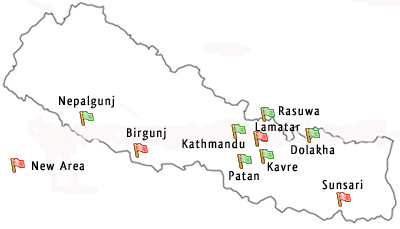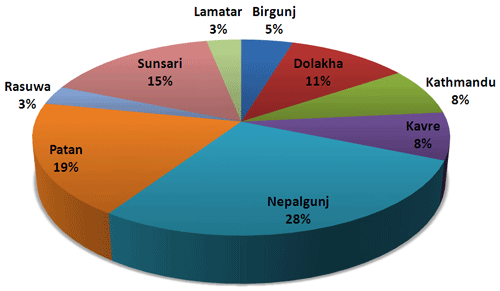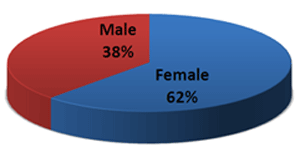NCEF provides financial assistance that enables many poor Nepalese children to attend school. Many children in Nepal—especially, the ones in rural areas—need financial assistance to continue their education. Due to limited resources, NCEF cannot support all the students that apply for financial assistance (through our area coordinators). Every year, the task of the selection committee is to identify the most needy students who would be supported by NCEF.
The Team:
The student selection committee for the year 2009-2010 consisted of the following members.
- Uttam Sharma (Chair)
- Bigyan Acharya
- Bhusan Neupane
- Hari Tripathi
- Laura Satkamp
- Maheshwor Kafle
|

Figure 1: NCEF’s areas of operation in Nepal
Procedure:
We collected applications for renewal of financial assistance from Dolakha, Kathmandu, Kavre, Rasuwa, Nepalgunj and Patan. This year NCEF decided to support additional students in Dolakha, and also include Birgunj, Lamatar, and Sunsari as new areas of operation. Several children from these areas applied to be considered for financial assistance for the first time.
Our first task was to define the criteria for student selection. These criteria can be viewed at http://www.nepalchildren.org/selection_criteria.html. Next, we designed the application forms for renewal as well as new students (available for download at http://www.nepalchildren.org/about.html#apps ).
Members Update
NCEF welcomes our new members Robin Tiwari, Shila Bhandari and Sudin Shrestha.
Contributions:
- Shila helped update constituent database and joined the DB management team.
- Sudin researched and presented online payment options
- Swadesh and Jay helped with donor letters
- Pratibha is helping us update facebook and twitter.
Want to get INVOLVED? [email protected]
We sent the application forms to our field volunteers in Nepal. Field volunteers distributed the new applications to schools as well as to the parents. They also distributed the renewal applications to all students that received financial assistance during the previous year.
Field volunteers collected the applications and academic transcripts from schools. They scanned all these documents, and emailed them to NCEF selection committee. For each renewal applicant, they also provided their recommendation on whether or not NCEF should continue funding the student. After receiving all the applications from an area, they were distributed to all the selection committee members.
The Selection Process:
NCEF’s financial resources and the availability of field volunteers determine the number of students selected from each area. For each area, every selection committee member ranks all the applicants based on their application and the recommendations from field volunteers. Average of this ranking is calculated for each student and top candidates from this list are selected for financial assistance. Ties were resolved through discussion and voting amongst the selection committee members. If certain renewal applications require special consideration, we review such applications carefully, often interacting with the field volunteers for additional information and document any requirements that are waived.
Results:
All together we selected 64 students. Some of the renewal applications were for students who had passed the SLC examination. These decisions could not be made until after the SLC examination results were declared, and hence, were made separately from the rest of the students.
One student required special consideration for funding approval. Under NCEF requirement, a student has to pass their final grade exam in order to be eligible for renewal of funding. This student failed the final exam. However, after careful analysis of the situation, and strong recommendation from the student’s teachers and field volunteer, the selection committee decided to fund the student who now has an opportunity to improve his/her grades. The student has been given formal notice that the funding is contingent upon demonstrated improvement of his/her study.

Figure 2: Breakdown of supported students in each area

Figure 3: Number of supported male and female students
Challenges:
One of the main challenges that selection committee faced this year was the inability to collect complete applications from Nepal on time. Most of the time, applications were incomplete, and some did not have academic reports. For renewal students we did not receive the applications of all students from each geographical location all at once. These problems led to the delay in student selection. The selection committee had to review the applications on an ongoing basis. This made the process challenging to get the ranking and review from all selection committee members on time.
Recommendations:
The main cause of delay for selection had been the applications not getting to the selection committee on time. Another issue is the veracity of the income levels reported in the new student applications. To the best of our knowledge, the field volunteers can rely only on the income level reported by the student’s family when filling out the application forms. In general, almost all our student applicants are from poor families and deserving of NCEF support. Unfortunately, since we cannot support all our applicants and family’s income is an important criterion for selection, NCEF is in the process of addressing this issue by developing more comprehensive and context-specific surveys to collect household resources.
Acknowledgments:
The selection committee would like to thank all the NCEF volunteers for collecting and sending student applications.
|
At the time of its inception, NCEF started providing scholarship of $100, roughly Nepali NRs 7,500 as yearly scholarships to each student. The aggregate inflation over the last eight years totals to about 49% while the USD has lost about 5% of its value against Nepali Rupees. The consumer prices have increased in the country, including the prices for educational materials such as stationery and school uniforms.

Are you in yet? Join our cause to receive announcements, view new pictures and videos. Invite your Friends!

Number of Members: 6,944
Donations from Cause: $1,179 |
In response to these economic changes in the country, NCEF decided to revisit the scholarship amount policy in Nepal last year. Our Nepali volunteer team constituting of Hari Tripathi, Shyam Gnawali, Bhusan Neupane, and led by Dr. Maheshwor Kafle, conducted a survey to examine whether the limit of NRs 7,500 was appropriate amount of scholarship for students in Nepal in 2010. This review was necessary because most of the NCEF students are progressing in their studies and finishing up the 10th grade National-level Board exam called School Leaving Certificate (SLC). They will be attending higher secondary education in the new system called 10+2 in Nepal which has a different cost structure than public schools below 10th grade in Nepal. We will present some information on how this advancement of students warrants revisit of the initial $100 scholarship limit.
Educational system in Nepal
For readers not familiar with the education system in Nepal, public schools are government-run schools where primary level education (grade 1-5) is free. However, Nepali Education system is undergoing changes and is advocating higher secondary level education extending beyond the tenth grade, called the 10+2 system, instead of the earlier system of Intermediate studies conducted in Universities. This will be equivalent to the junior and senior level of school in high schools in the US. Although most private run schools have extended their service to include 10+2 education, most public schools are yet to implement this service or implement it fully. As a result, most NCEF students would have to attend private schools if they are to continue their education in a timely manner.
Survey Methodology
The survey team had prepared a brief questionnaire regarding fee structures in the different public and private schools of Nepal that offer services from grade 1 through 12. The team members called a number of schools to obtain information about their fee structure. Based on this information and his own experience working with NCEF-sponsored students’ cost of education, Dr. Maheshwor Kafle prepared the following report:
Survey results and Recommendations
a. Public schools grades 1-10
Results: Although public schools until at least the fifth grade are claimed to be free, the schools charge miscellaneous amount categorized under costs of admission fee, development fee, exam fee and so on, but this amount is usually less than NRs. 3,000 per year.
Recommendation: For public schools, between grades 1-10, the limit of NRs. 7,500 ~ $100 is appropriate. NCEF can buy a set of stationeries and educational supplies and a set of uniform with the amount remaining after paying the miscellaneous fees. Hence, for public schools, NCEF does not need to increase grant per student.
b. Private Schools grades 1-10
Results: For Private schools, the fees range over a big amount. There are some schools that charge admission fees of NRs 10,000 – 150,000 (US equiv $133-$2,000) and then several other miscellaneous fees like exam fees, in addition to the monthly fees that range anywhere between NRs 500 to 2,000.
Recommendation: Under NCEF’s grant limit, private schools are not affordable. NCEF needs to determine if there is a need to support students currently in private school. Until now, NCEF has been providing the yearly NRs 7,500 to students attending private schools who bear the additional cost through other means.
There will always be a debate about the quality of education offered in public vs. private school in Nepal. It is true that private schools do better than public school judging by the students’ success rate in the annual SLC.
However, keeping in mind that our goal is to send children to school who otherwise would not be attending any kind of school, we believe providing education to children is the foremost priority. Whenever it is financially feasible, NCEF can send students to private schools. One strategy would be to use private schools until a certain grade where fees are not exorbitant and then students can go to public school for remaining education although this may take readjustment on the part of the student.
c. Private vs. Public Schools for 10+2 education
Results: The fees for the private schools for 10+2 level education are much higher than the annual NRs 7,500. It would be impossible to support students in private schools in this budget. Even the public schools’ 10+2 education is costlier even if the humanities and management major is considered. For students interested in specializing in science, the budget is still not enough. [Note to readers: In Nepali education system, students start specializing in either science, management, or humanities/social sciences since high school].
Recommendation: To send NCEF students to public school, NCEF will have to increase the grant limit to NRs 10,000 ($133) a year. Even with an increase of budget, students will be able to attend public schools and specialize in management and humanities only.
Actions taken based on this report
Based on this report, the executive committee has increased the yearly budget to NRs 10,000 and equiv US $133 for students continuing to 10+2 education. NCEF aims to continue to monitor the needs of the students and make decisions accordingly in terms of grant limit in the future. |
